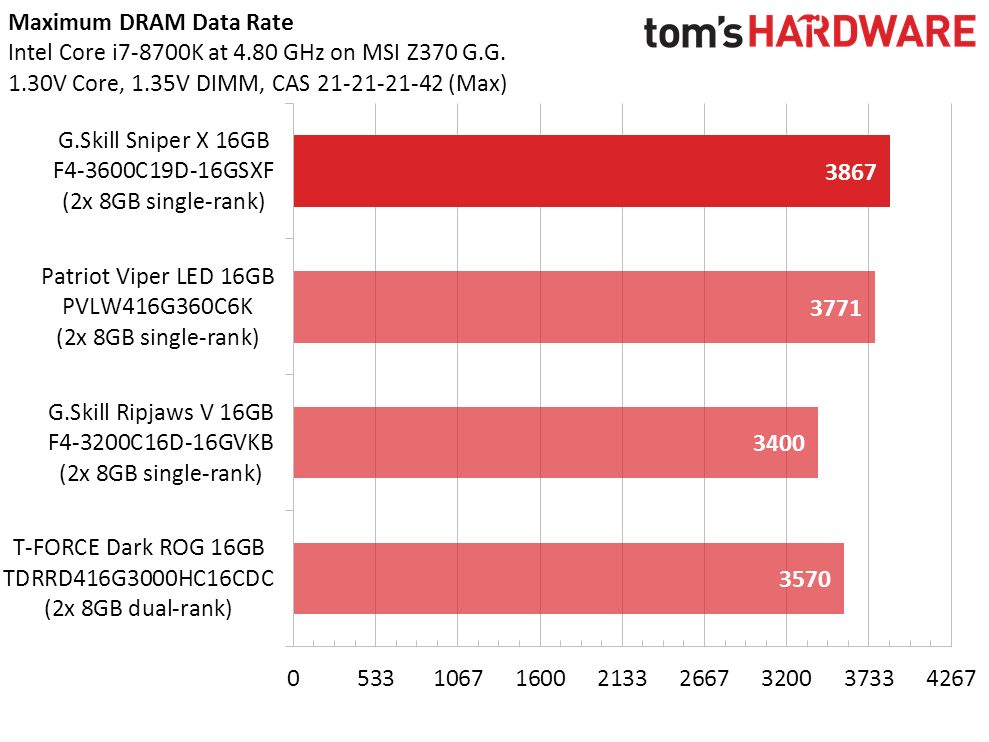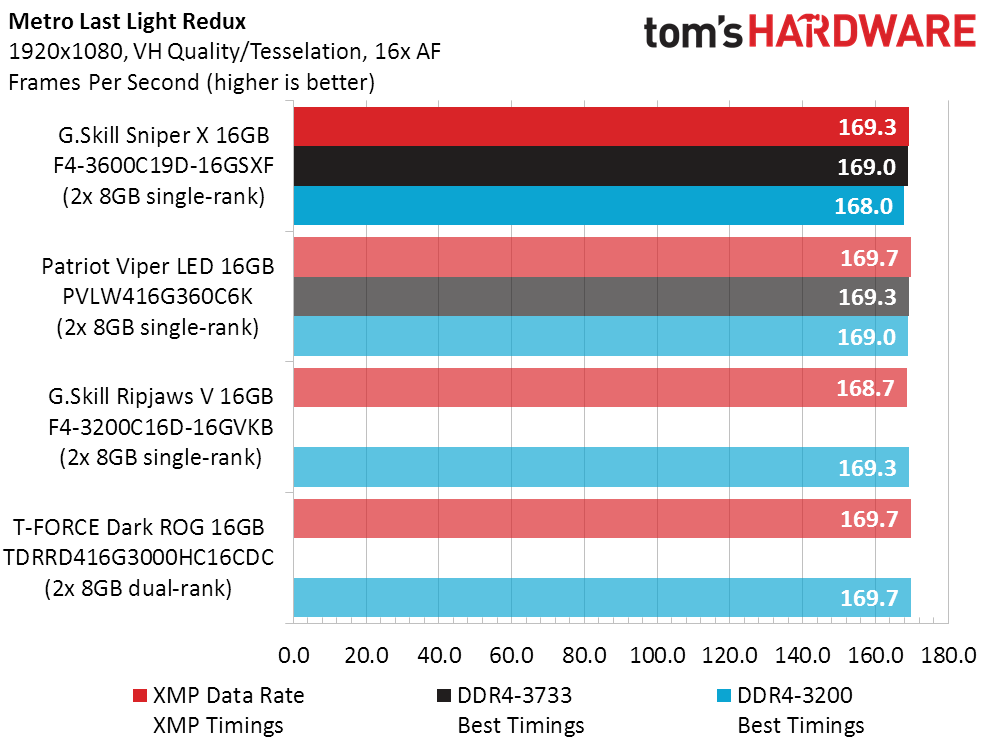G.Skill Sniper X 16GB DDR4-3600 C19 Kit Review: Value in Camouflage
Why you can trust Tom's Hardware
Benchmark Results & Final Analysis
Since latency is a bad thing, we tried finding the lowest stable timing set for each module kit. Our motherboard couldn’t configure the Viper LED kit to workable DDR4-2666 or DDR4-2400 advanced timings, so we’ve excluded those from today’s benchmark charts. This has proven to be a firmware limitation, since it previously applied to some memory from another brand.
| Lowest Stable Timings at 1.35V (Max) on MSI Z370 Godlike Gaming (BIOS A.30) | ||||
| Row 1 - Cell 0 | DDR4-3733 | DDR4-3200 | DDR4-2666 | DDR4-2400 |
| G.Skill Sniper X 16GB F4-3600C19D-16GSXF | 19-20-20-40 (2T) | 16-17-17-34 (1T) | 13-14-14-28 (1T) | 12-13-13-28 (1T) |
| Patriot Viper LED 16GB PVLW416G360C6K | 18-19-19-38 (2T) | 15-16-16-32 (1T) | X | X |
| G.Skill Ripjaws V 16GB F4-3200C16D-16GVKB | X | 15-16-16-32 (1T) | 13-13-13-28 (1T) | 11-11-11-28 (1T) |
| T-Force Dark ROG 16GB TDRRD416G3000HC16CDC | X | 16-17-17-34 (1T) | 13-14-14-28 (1T) | 12-13-13-28 (1T) |
The Sniper X DDR4-3600 is the first RAM we’ve tested that overclocked higher using 21-21-21-42 primary timings, as opposed to 19-21-21-42. The difference was only a few MHz, as the same kit reached 19-20-20-40 timings at DDR4-3733.
Sandra Memory Bandwidth shows the mid-priced Sniper X trailing the higher-priced Viper LED at all settings, which makes sense since it requires slower primary timings. The barely-still-available dual-rank kit edges out both, when manually configured to optimal performance settings.
Lower is better when it comes to latency, and the Sniper X falls slightly behind the Viper LED there, as well. As an aside, the dual-rank kit started off with poor timings but tuned up nicely.
F1 2015 has unusually high memory bottlenecks compared to games that aren’t based on the EGO game engine, and it awards the Viper LED’s high data rate and good timings with a big lead over other single-rank modules. Even the dual-rank kit requires manual tuning to beat it. Could this test be the Sniper X’s Achilles’ heel?
As with most other games, Metro Last Light Redux has a fairly low memory performance requirement, after which other factors such as the graphics card are most important. The Sniper X loss is trivial.
Blender CPU Render is typical of most non-gaming apps, in that it too has a fairly low memory performance requirement, after which the CPU becomes the bottleneck. All compared kits satisfy its needs.
Get Tom's Hardware's best news and in-depth reviews, straight to your inbox.
Remembering that less completion time means more performance, long bars on the Sniper X in 7-Zip mean that it loses noticeably. Even the Ripjaws V DDR4-3200 could be tweaked to produce lower completion time.
Price is where Sniper X takes its victory dance on Viper LED, its 11% lower cost offsetting its 6% lower performance to give it a margin in value. If you’re still looking at the dual-rank kit as a possible alternative, it might be gone.
And so the Sniper X takes the value edge over Viper LED, and the only things buyers must question is whether their specific apps are among the few that can benefit from the Viper LED’s performance lead, and whether or not they’re willing to also pay for the Viper LED’s lighting.
MORE: Best Memory
MORE: DDR DRAM FAQs And Troubleshooting Guide
MORE: All Memory Content
-
marcelo_vidal I get a dual 1366 board new for 100 dollar and 1 dollar for two quad core cpus and with 60 dollar i will get 48gb ddr3 ecc. Why spend 200 dollar in 16gb of ram ?Reply -
Gam3r01 Reply20869135 said:I get a dual 1366 board new for 100 dollar and 1 dollar for two quad core cpus and with 60 dollar i will get 48gb ddr3 ecc. Why spend 200 dollar in 16gb of ram ?
Because you are comparing outdated server hardware to high end modern RAM?
There is literally no comparison here. -
Crashman Reply
There's always a strain of responses from people who either didn't notice the memory price inflation of 2017, or want us to assign the blame for that inflation to whatever model we're reviewing.20869418 said:20869135 said:I get a dual 1366 board new for 100 dollar and 1 dollar for two quad core cpus and with 60 dollar i will get 48gb ddr3 ecc. Why spend 200 dollar in 16gb of ram ?
Because you are comparing outdated server hardware to high end modern RAM?
There is literally no comparison here.
-
gaborbarla I would love to see a more comprehensive version of this article. Something like a couple of Corsair Vengeances thrown in there as well as basic value RAM that most people buy.Reply
I have done quite a bit of research on whether it is worth it to worry about RAM for gaming, and the answer is turned out to be a definite yes. The reason however is not a massive increase in max FPS. Only very few games like F1 2015 make a difference with faster RAM in these tests. But most games will make a difference in MIN FPS. At the time when there are explosions and other hectic things going on, often faster RAM will reduce the stutter by up to 30%. Many people know what I am talking about. Those pesky slowdowns is what I want to get rid of, and fast RAM does actually help with that apparently. It seems that one can definitely not go simply on MHz of the RAM. Thanks for the informative article. After seeing this article the Viper really caught my eye. It should be quite good at reducing MIN FPS stutter. -
Crashman Reply
Since latency is the inverse of frequency, DDR4-3600 CAS 18, DDR4-3200 CAS 16, DDR4-2800 CAS 14, and DDR4-2400 CAS 12 all have the same real-time latency. When you're talking about latency-specific applications, it's best to keep in mind that your best performance will happen with the lowest real-time latency. If we use "Double the latency cycles and add two zeros" for the baseline data rate at any given latency group, this specific kit is slightly slower than the 3600-18 baseline at 3600-19, and gets no performance-specific recommendation. It's price competitively though.20869634 said:I would love to see a more comprehensive version of this article. Something like a couple of Corsair Vengeances thrown in there as well as basic value RAM that most people buy.
I have done quite a bit of research on whether it is worth it to worry about RAM for gaming, and the answer is turned out to be a definite yes. The reason however is not a massive increase in max FPS. Only very few games like F1 2015 make a difference with faster RAM in these tests. But most games will make a difference in MIN FPS. At the time when there are explosions and other hectic things going on, often faster RAM will reduce the stutter by up to 30%. Many people know what I am talking about. Those pesky slowdowns is what I want to get rid of, and fast RAM does actually help with that apparently. It seems that one can definitely not go simply on MHz of the RAM. Thanks for the informative article. After seeing this article the Viper really caught my eye. It should be quite good at reducing MIN FPS stutter.
Most people still need a calculator to determine that DDR4-3600 CAS 16 is going to be quicker than DDR4-2800 CAS 13. And while people with a good mind for proportion will automatically understand that 3600 CAS 19 is going to be quicker than 2800-15 (because the one extra cycle is a smaller portion of the total latency cycles), we have to keep in mind that not everyone has that mindset. Using "double-the-latency then add-two-zeros" as a baseline is a good method for people who don't want to bother with the calculator. Using that method for CAS 19, you'd expect DDR4-3800, and since it's DDR4-3600, you can think "it's slower than the performance-DRAM baseline".








